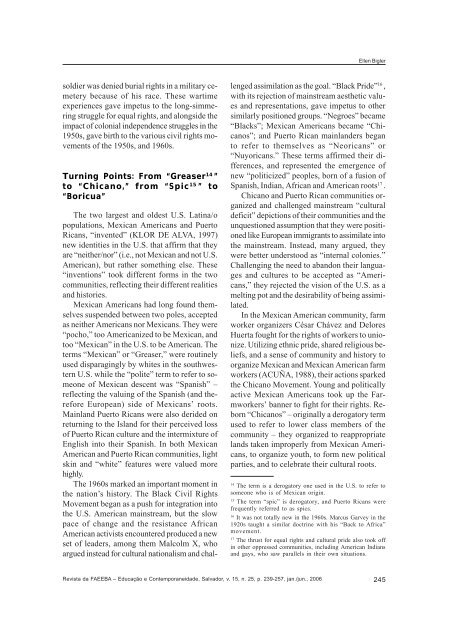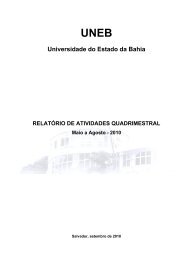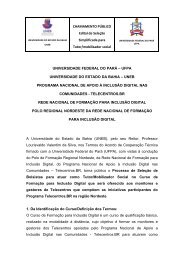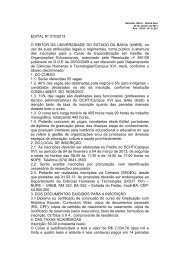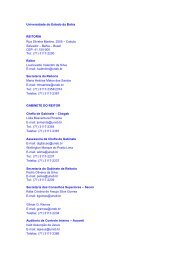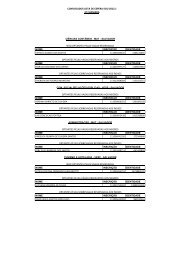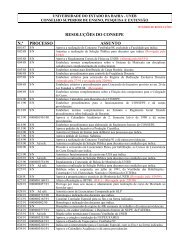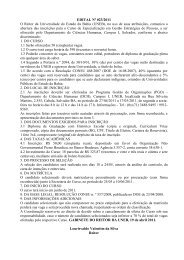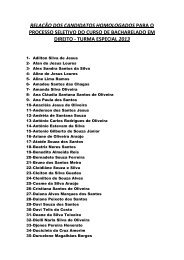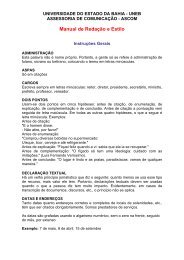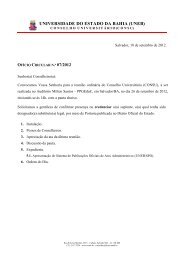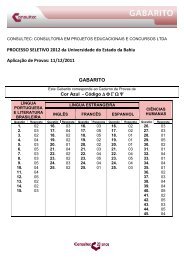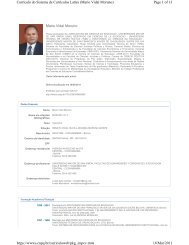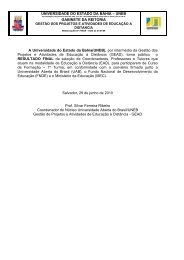Revista da FAEEBA Educação e Contemporaneidade - Uneb
Revista da FAEEBA Educação e Contemporaneidade - Uneb
Revista da FAEEBA Educação e Contemporaneidade - Uneb
Create successful ePaper yourself
Turn your PDF publications into a flip-book with our unique Google optimized e-Paper software.
soldier was denied burial rights in a military cemetery<br />
because of his race. These wartime<br />
experiences gave impetus to the long-simmering<br />
struggle for equal rights, and alongside the<br />
impact of colonial independence struggles in the<br />
1950s, gave birth to the various civil rights movements<br />
of the 1950s, and 1960s.<br />
Turning Points: From “Greaser 14 ”<br />
to “Chicano,” from “Spic 15 ” to<br />
“Boricua”<br />
The two largest and oldest U.S. Latina/o<br />
populations, Mexican Americans and Puerto<br />
Ricans, “invented” (KLOR DE ALVA, 1997)<br />
new identities in the U.S. that affirm that they<br />
are “neither/nor” (i.e., not Mexican and not U.S.<br />
American), but rather something else. These<br />
“inventions” took different forms in the two<br />
communities, reflecting their different realities<br />
and histories.<br />
Mexican Americans had long found themselves<br />
suspended between two poles, accepted<br />
as neither Americans nor Mexicans. They were<br />
“pocho,” too Americanized to be Mexican, and<br />
too “Mexican” in the U.S. to be American. The<br />
terms “Mexican” or “Greaser,” were routinely<br />
used disparagingly by whites in the southwestern<br />
U.S. while the “polite” term to refer to someone<br />
of Mexican descent was “Spanish” –<br />
reflecting the valuing of the Spanish (and therefore<br />
European) side of Mexicans’ roots.<br />
Mainland Puerto Ricans were also derided on<br />
returning to the Island for their perceived loss<br />
of Puerto Rican culture and the intermixture of<br />
English into their Spanish. In both Mexican<br />
American and Puerto Rican communities, light<br />
skin and “white” features were valued more<br />
highly.<br />
The 1960s marked an important moment in<br />
the nation’s history. The Black Civil Rights<br />
Movement began as a push for integration into<br />
the U.S. American mainstream, but the slow<br />
pace of change and the resistance African<br />
American activists encountered produced a new<br />
set of leaders, among them Malcolm X, who<br />
argued instead for cultural nationalism and chal-<br />
Ellen Bigler<br />
lenged assimilation as the goal. “Black Pride” 16 ,<br />
with its rejection of mainstream aesthetic values<br />
and representations, gave impetus to other<br />
similarly positioned groups. “Negroes” became<br />
“Blacks”; Mexican Americans became “Chicanos”;<br />
and Puerto Rican mainlanders began<br />
to refer to themselves as “Neoricans” or<br />
“Nuyoricans.” These terms affirmed their differences,<br />
and represented the emergence of<br />
new “politicized” peoples, born of a fusion of<br />
Spanish, Indian, African and American roots 17 .<br />
Chicano and Puerto Rican communities organized<br />
and challenged mainstream “cultural<br />
deficit” depictions of their communities and the<br />
unquestioned assumption that they were positioned<br />
like European immigrants to assimilate into<br />
the mainstream. Instead, many argued, they<br />
were better understood as “internal colonies.”<br />
Challenging the need to abandon their languages<br />
and cultures to be accepted as “Americans,”<br />
they rejected the vision of the U.S. as a<br />
melting pot and the desirability of being assimilated.<br />
In the Mexican American community, farm<br />
worker organizers César Chávez and Delores<br />
Huerta fought for the rights of workers to unionize.<br />
Utilizing ethnic pride, shared religious beliefs,<br />
and a sense of community and history to<br />
organize Mexican and Mexican American farm<br />
workers (ACUÑA, 1988), their actions sparked<br />
the Chicano Movement. Young and politically<br />
active Mexican Americans took up the Farmworkers’<br />
banner to fight for their rights. Reborn<br />
“Chicanos” – originally a derogatory term<br />
used to refer to lower class members of the<br />
community – they organized to reappropriate<br />
lands taken improperly from Mexican Americans,<br />
to organize youth, to form new political<br />
parties, and to celebrate their cultural roots.<br />
14 The term is a derogatory one used in the U.S. to refer to<br />
someone who is of Mexican origin.<br />
15 The term “spic” is derogatory, and Puerto Ricans were<br />
frequently referred to as spics.<br />
16 It was not totally new in the 1960s. Marcus Garvey in the<br />
1920s taught a similar doctrine with his “Back to Africa”<br />
movement.<br />
17 The thrust for equal rights and cultural pride also took off<br />
in other oppressed communities, including American Indians<br />
and gays, who saw parallels in their own situations.<br />
<strong>Revista</strong> <strong>da</strong> <strong>FAEEBA</strong> – <strong>Educação</strong> e Contemporanei<strong>da</strong>de, Salvador, v. 15, n. 25, p. 239-257, jan./jun., 2006 245


